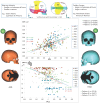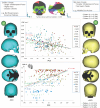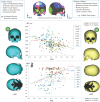Bioclimatic and masticatory influences on human cranial diversity verified by analysis of 3D morphometric homologous models
- PMID: 39496664
- PMCID: PMC11535542
- DOI: 10.1038/s41598-024-76715-0
Bioclimatic and masticatory influences on human cranial diversity verified by analysis of 3D morphometric homologous models
Abstract
This study analyzes the effects of bioclimate and masticatory factors on the regional variability of human cranial forms across 150 ethnic groups worldwide. Morphometric variables were generated using principal component analysis applied to 3D homologous models. Relationships between cranial form and bioclimate (temperature and precipitation) and masticatory factors (infratemporal space) were tested considering sampling bias due to past population movements during the late Pleistocene and/or early- to mid-Holocene. Cranial size correlated with thermal conditions, consistent with Bergmann's rule. The length/breadth proportion of the neurocranium aligned with Allen's rule for thermal adaptation, while no relationship with masticatory stress was found. Facial form responded to either climate or masticatory conditions, although the primary factor was unclear due to the high correlation between stresses. However, masticatory stress was identified as an equally significant factor behind facial flatness in cold regions, else than the effect of Allen's rule. High narrowness of nasal and orbital openings correlated significantly with cold temperatures and cranial size, suggesting not only functional but also allometric effect. This study demonstrated the complexity of environmental influences on cranial form diversity, nonetheless suggested reduction of selective pressure on cranial form caused by natural environmental stress due to the development of civilization.
Keywords: 3D homologous; Adaptation; Climate; Human crania; Masticatory; Morphometric.
© 2024. The Author(s).
Conflict of interest statement
The authors declare no competing interests.
Figures






Similar articles
-
Global patterns of the cranial form of modern human populations described by analysis of a 3D surface homologous model.Sci Rep. 2022 Aug 15;12(1):13826. doi: 10.1038/s41598-022-15883-3. Sci Rep. 2022. PMID: 35970916 Free PMC article.
-
Temperature-dependent Developmental Plasticity and Its Effects on Allen's and Bergmann's Rules in Endotherms.Integr Comp Biol. 2023 Sep 15;63(3):758-771. doi: 10.1093/icb/icad026. Integr Comp Biol. 2023. PMID: 37160342 Free PMC article.
-
Functional adaptation rather than ecogeographical rules determine body-size metrics along a thermal cline with elevation in the Chinese pygmy dormouse (Typhlomys cinereus).J Therm Biol. 2020 Feb;88:102510. doi: 10.1016/j.jtherbio.2020.102510. Epub 2020 Jan 3. J Therm Biol. 2020. PMID: 32125991
-
[Specifics of mastication with complete dentures].Med Pregl. 1999 Nov-Dec;52(11-12):464-8. Med Pregl. 1999. PMID: 10748769 Review. Croatian.
-
A quantitative analysis of the Eutherian orbit: correlations with masticatory apparatus.Biol Rev Camb Philos Soc. 2008 Feb;83(1):35-69. doi: 10.1111/j.1469-185X.2007.00031.x. Biol Rev Camb Philos Soc. 2008. PMID: 18211281 Review.
Cited by
-
From Calibrated Morphs to Facial Stimuli: The Beauty of a Statistically Informed Picture.Am J Hum Biol. 2025 May;37(5):e70048. doi: 10.1002/ajhb.70048. Am J Hum Biol. 2025. PMID: 40325797 Free PMC article. No abstract available.
References
-
- Lacruz, R. S. et al. The evolutionary history of the human face. Nat. Ecol. Evol.3, 726–736. 10.1038/s41559-019-0865-7 (2019). - PubMed
-
- Wolpoff, M. H. Climatic influence on the skeletal nasal aperture. Am. J. Phys. Anthropol.29, 405–423. 10.1002/ajpa.1330290315 (1968). - PubMed
-
- Beals, K. L. Head form and climatic stress. Am. J. Phys. Anthropol.37, 85–92. 10.1002/ajpa.1330370111 (1972). - PubMed
-
- Beals, K. L., Smith, C. L. & Dodd, S. M. Climate and the evolution of brachycephalization. Am. J. Phys. Anthropol.62, 425–437. 10.1002/ajpa.1330620407 (1983). - PubMed
-
- Beals, K. L. et al. Brain size, cranial morphology, climate, and time machines [and comments and reply]. Curr. Anthropol.25, 301–330. 10.1086/203138 (1984).
MeSH terms
Grants and funding
LinkOut - more resources
Full Text Sources
Miscellaneous

